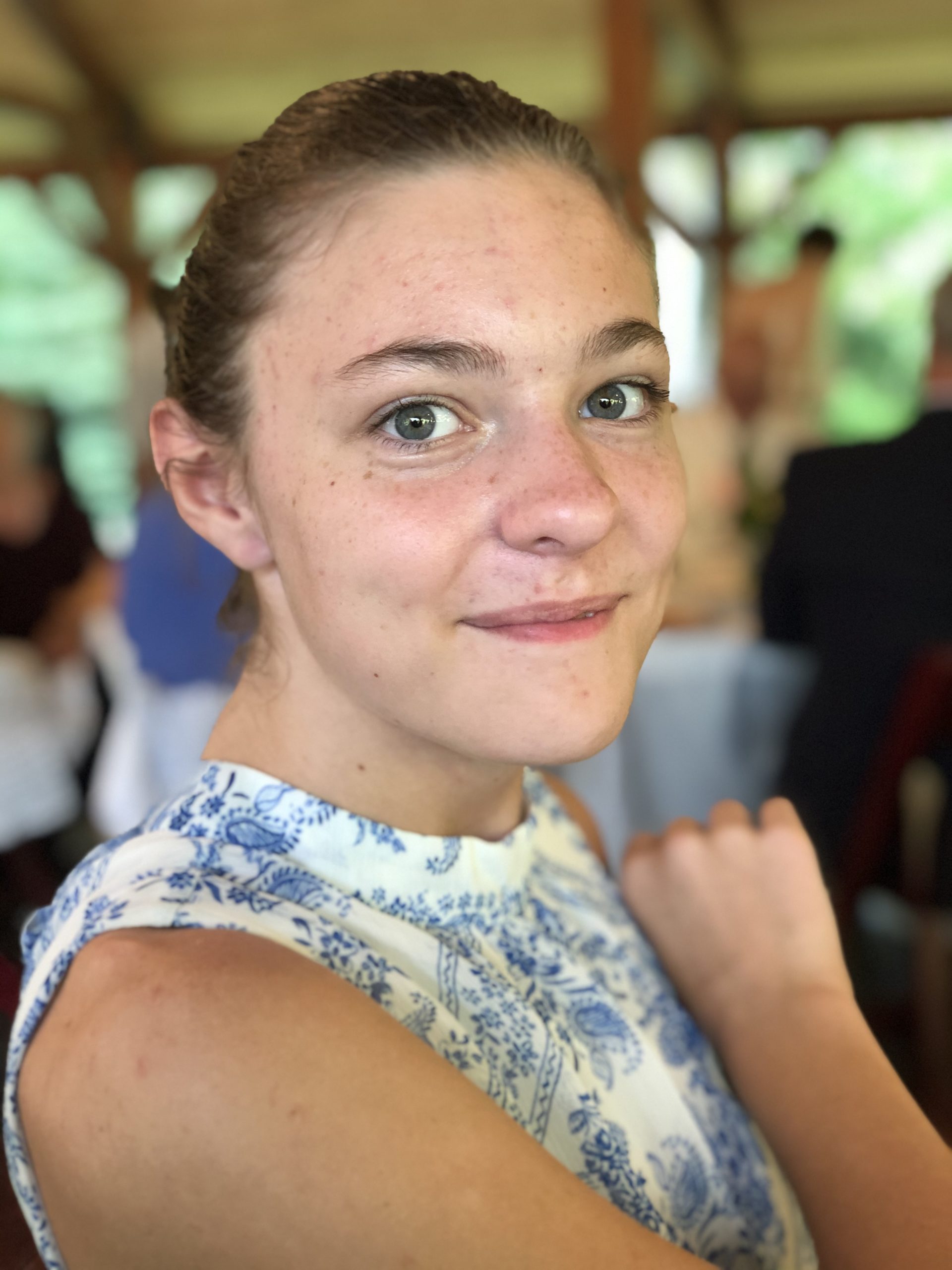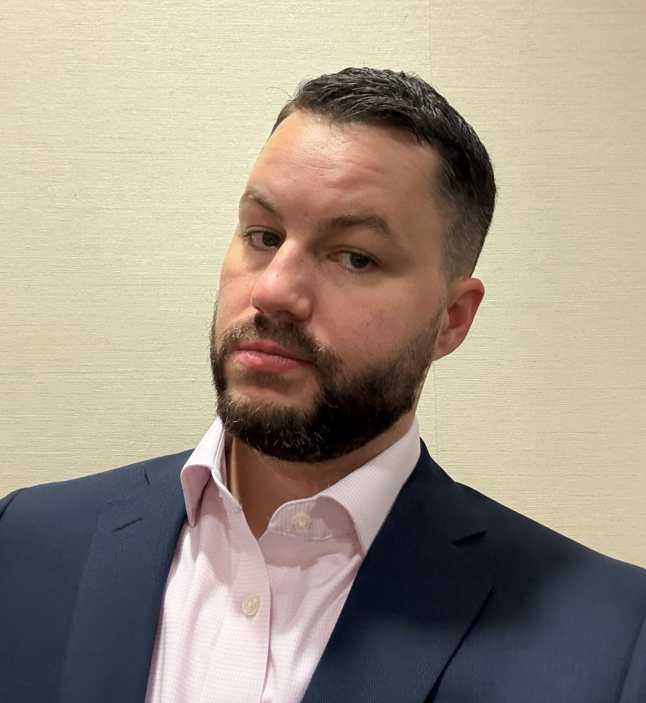

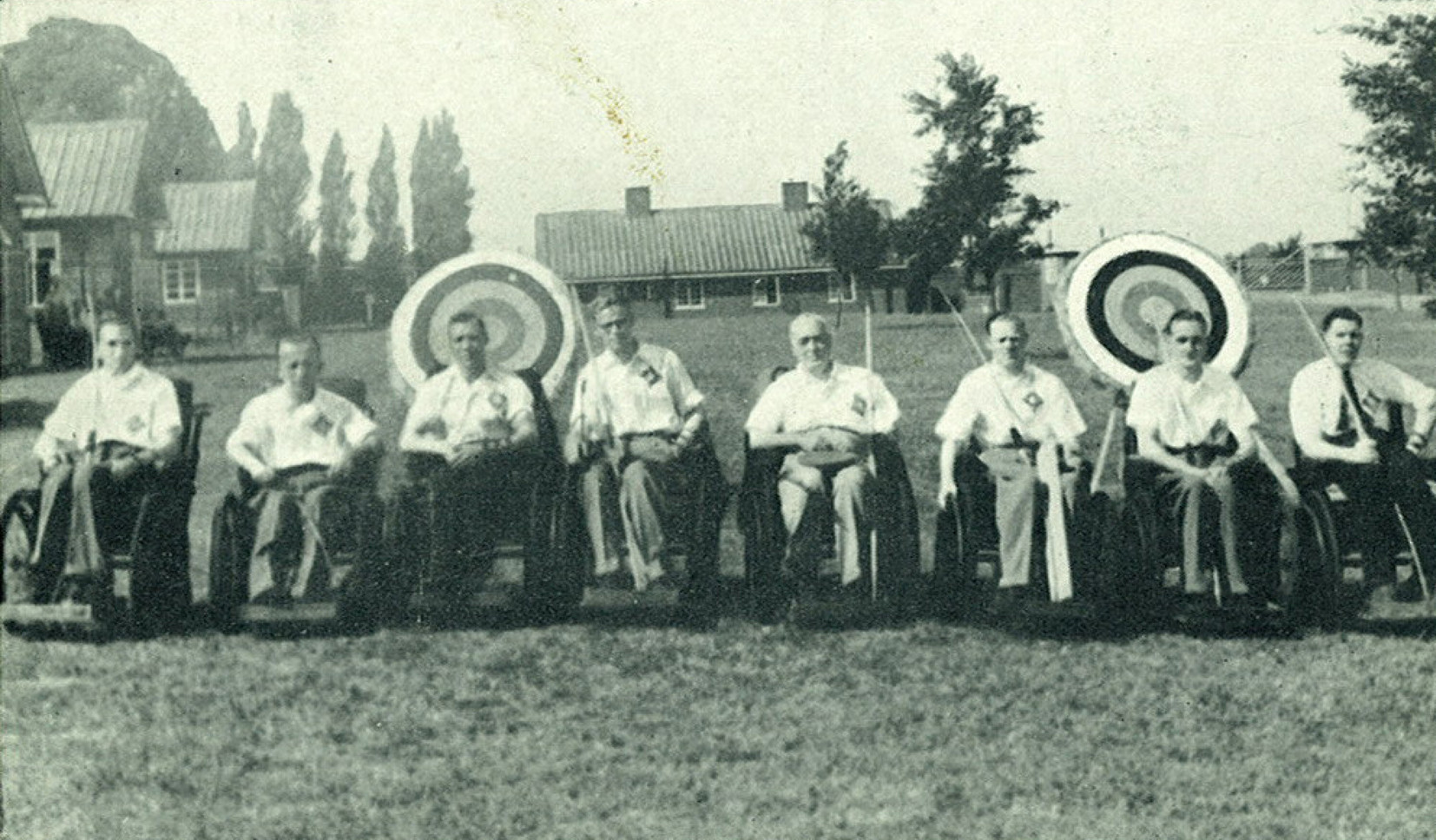
History
History is not a burden on the memory but an illumination of the soul.
Lord Acton
VIRTUAL History Timeline – Text Only Pdf
The purpose of the timeline is to honor the rich history of Move United. This timeline is written with the intention of celebrating the milestones in which this organization has accomplished, along with the many triumphs of the Disability Rights movement in the USA.
From the beginning as the National Wheelchair Athletic Association to its final name change, there have been a great number of individuals and groups involved with this organization. The sample of the historic milestones mentioned in this timeline would not have been possible if it weren’t for the countless number of passionate and dedicated heroes and pioneering mothers and fathers, who care about the mission of this organization. Many molded the organization and solidified its foundation.
During the organization’s first few decades, major events and activities took place that complimented the purpose of the organization like the disability rights movement and its respective legislative accomplishments, the initial development and networking between like minded organizations, both nationally and internationally, the evolution of publications and public relation efforts networking with mainstream media and the early days of road racing. Since those days through 2020, we have seen integration and inclusion of individuals with a disability in sport and in everyday life. Additionally, we have seen the evolution of adaptive equipment and training and education opportunities and an increase in the overall awareness of disability in our society. It started here. To the many athletes and their family members, staff and volunteers, coaches, officials, classifiers, event directors, allied health members, member organizations, sponsors, donors, and partners, we thank you for your dedicated efforts to the sustainability, growth, and impact of this organization.
Each decade, excellence has been seen. From Marty Ball, Cliff Crase, Randy Snow, and David Williamson, to Candance Cable, Jean Driscoll, Ann Cody, Linda Mastandrea, and Scot Hollonbeck. From Dr. Cheri Blauwet, Amanda McGrory, Jessica (Galli) Cloy, and Anjali Forber-Pratt to Tatyana McFadden, Ray Martin, Joshua George, and Daniel Romanchuk. The history of Adaptive Sports USA is phenomenal. What endless possibilities exist in the future? We can’t wait to be a part of it, providing sport opportunities to individuals with a disability and training, education, and awareness to the public in order to positively impact our greater community. Rest assured our long standing history is not being forgotten, but will be enhanced moving forward as Adaptive Sports USA and Disabled Sports USA become Move United.
Please excuse any errors and/or omissions. This is a sample, not an exclusive list, and is a living and breathing historical document.
The First International Silent Games
Move United
From August 10th to August 17th, nine European countries were represented in the first international competition forathletes with a disability. The competition took place in Paris, France.
Wheelchair Basketball First Welcomed in the U.S.
Move United
Wheelchair basketball was introduced as a form of rehabilitation for people who served in World War II. Around the same time, Sir Ludwig Guttmann came up with wheelchair netball, a similar sport game, at the Spinal Rehabilitation Hospital in Stoke Mandeville, Great Britain. Over time, the leadership from the National Wheelchair Athletic Association (NWAA) and their networking efforts helped to grow the sport of wheelchair basketball, internationally. Stan Labanowich, as National Wheelchair Basketball Association (NWBA) Commissioner, was also on the NWAA Executive Board. He provided much liaison networking that positively affected disabled athletes as a whole.
Paralyzed Veterans of America (PVA)
Move United
The PVA was founded by service members with spinal cord injuries as an organization to empower and advocate for the men and women who served. Members of the PVA played a major role in the leading and funding of the NWAA, including helping to create the organization as well.
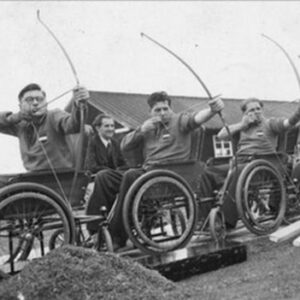
The Stoke Mandeville Games
Move United
On July 29th, neurosurgeon, Sir Ludwig Guttman, founder of the Spinal Injury Center in Stoke Mandeville, England, organized a competition held for 16 veterans in wheelchairs in the sport of archery. The games were named after the nearby hospital. Inspired by the 1948 Olympic Games in London, England, the Stoke Mandeville Games ultimately led to the foundation for the Paralympic Games.
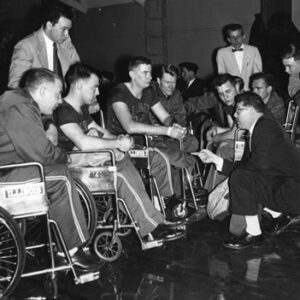
University of Illinois “Gizz Kids”
Move United
In 1948, the University of Illinois at Galesburg began a highly specialized program in competitive sports, which they coined, the “U of Illinois Gizz Kids.” Professor Timothy J. Nugent was a catalyst in this push for wheelchair sports. He is known worldwide as the founder of the NWBA, the famous Gizz Kids wheelchair basketball team, and the Ms. Kids, the first women’s team.

National Wheelchair Athletic Association “NWAA”
Move United
The inception of Adaptive Sports USA was in 1956 with committee work that led to the 1974 incorporation of the National Wheelchair Athletic Association (NWAA). Founded as the NWAA through the National Wheelchair Athletic Committee, the initial impetus grew out of the interests of athletes with a disability, many of whom were veterans of World War II. This was the beginning of an organization that became a leader in “promoting active, healthy lifestyles through recreational and competitive sport for individuals with a physical disability.” A number of influential individuals were members of the BRAIN Trust, which developed and created the NWAA. A few honorable mentions include Ben Lipton, Anne Lipton, the Bulova Watch Company and the Bulova School of Watchmaking, Sy Bloom, Charlie Ryder, Alonza Wilkins, and General Omar Bradley. These individuals also comprised the U.S. Teams’ leadership and administration well into the late 1970s.
Emergence of The International Stoke Mandeville Games Committee (ISMGC)
Move United
Due to the success of the Stoke Mandeville Games, the ISMGC was founded to propel the Games forward and led to the first Paralympic Games in Rome, Italy.

1st National Wheelchair Games
Move United
Created by the NWAA, the National Wheelchair Games were introduced by the Bulova School of Watchmaking in cooperation with the Paralyzed Veterans of America and Adelphi College and were hosted for the first time in the summer of 1957 at Adelphi University in Garden City, NY. Following the pattern set by Dr. Ludwig Gutmann, the games were planned to provide a variety of competitive sports for those with disabilities.
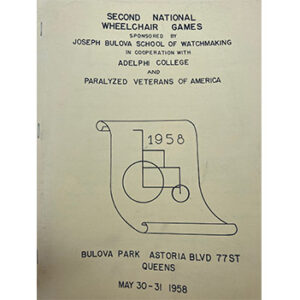
National Wheelchair Games Moved
Move United
National Wheelchair Games were moved to Bulova Park in Jackson Heights, NY and remained there through 1973.
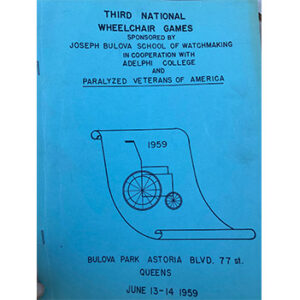
National Wheelchair Games
Move United
National Wheelchair Games held in Jackson Heights, NY
Disability Rights Movement
Move United
Due to the growing number of disabled veterans returning from war, 20th century wars sparked the rise in disability rights movements. The push for civil rights and disability rights around the world gained momentum in the 1960’s.
The First Paralympic Games
Move United
From September 18th to the 25th, 1960, the first Paralympic Games were held in Rome, Italy. At the Games, 400 athletes represented 23 different countries, including the U.S. The National Wheelchair Athletic Committee fielded the team representing the U.S. led by Team Leader, Ben Lipton.

Women start to compete in national competition
Move United
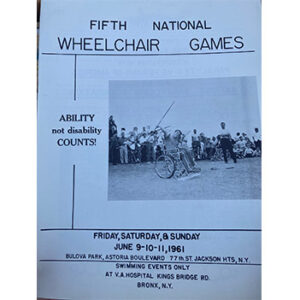
National Wheelchair Games
Move United
National Wheelchair Games held in Jackson Heights, NY
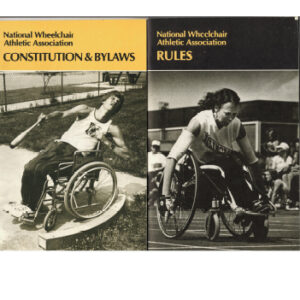
The National Wheelchair Athletic Rules Committee was formed
Move United
The committee established rules and regulations which governed wheelchair sports in the U.S. excluding those formed by the NWBA. Additionally, the committee recorded and maintained wheelchair athletic records, the selection of teams, the section of sites for future events and was a resource for consultation and advice around the country as it related to wheelchair sports.
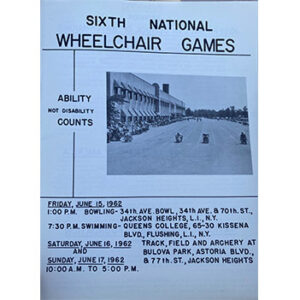
National Wheelchair Games
Move United
National Wheelchair Games held in Jackson Heights, NY
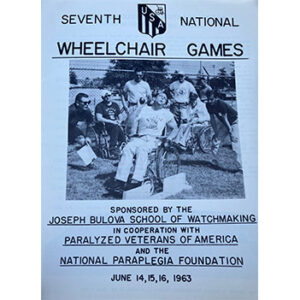
National Wheelchair Games
Move United
National Wheelchair Games held in Jackson Heights, NY
International Sports Organization for the Disabled
Move United
The International Sports Organization for the Disabled (ISOD) was founded to make competitive sport more inclusive. There were more people than known with visual impairments, amputations, and other disabilities who wanted to compete in sports – this was the driving force behind the ISOD. The ISOD fought hard for inclusion of visually impaired and athletes with amputations.
Paralympic Games held in Tokyo, Japan
Move United
The NWAA fielded the wheelchair team representing the U.S. at the Paralympic Games held in summer of 1964 in Tokyo, Japan.
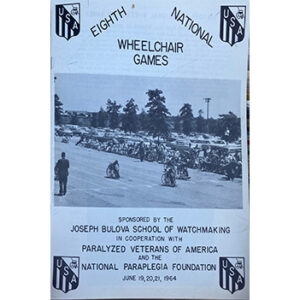
National Wheelchair Games
Move United
National Wheelchair Games held in Jackson Heights, NY
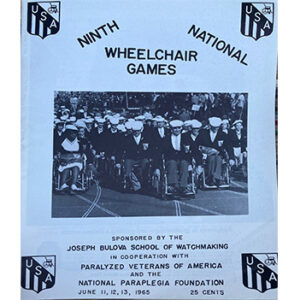
National Wheelchair Games
Move United
National Wheelchair Games held in Jackson Heights, NY

National Wheelchair Games
Move United
National Wheelchair Games held in Jackson Heights, NY
The National Amputee Skiers Association (NASA)
Move United
NASA was founded with three chapters. Was renamed to National Handicapped Sports and Recreation (NHSRA) and provided additional movement for adaptive sports.
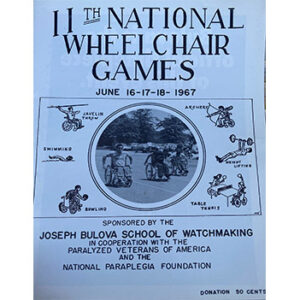
National Wheelchair Games
Move United
National Wheelchair Games held in Jackson Heights, NY
The First Special Olympic World Games
Move United
On July 20th, one thousand athletes with intellectual disabilities gathered together from the United States and Canada. The games took place in Chicago, Illinois. Recognized by the International Olympic Committee today, this movement continues to bring people together from 170 countries.
The Paralympic Games were held in Tel Aviv
Move United
The NWAA fielded the wheelchair team representing the U.S. at the Paralympic Games held in summer of 1968 in Tel Aviv, Israel.
Architectural Barriers Act (ABA)
Move United
The ABA of 1968 required that all federally funded facilities and buildings be made accessible, and if not, renovations be made so with federal funding. This was the first measure by Congress to ensure accessibility to buildings for people with disabilities.
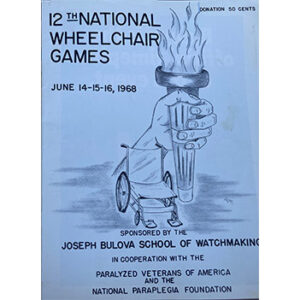
National Wheelchair Games
Move United
National Wheelchair Games held in Jackson Heights, NY
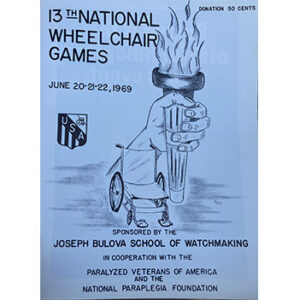
National Wheelchair Games
Move United
National Wheelchair Games held in Jackson Heights, NY
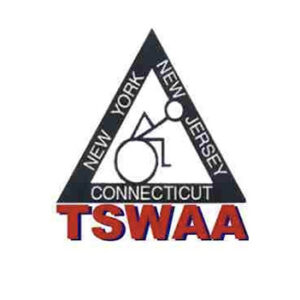
First Regional multi-sport competition created with the Tri-State Wheelchair and Ambulatory Games in NJ
Move United
Operated by the Tri-State Wheelchair Athletic Association, a NWAA chapter member.
Hall of Fame
Move United
The NWAA Hall of Fame was established in 1970 with Sy Bloom as the first Chair of the Committee, followed by Al Youakim in 1974, and Cliff Crase from 1976-2004. Since the creation of the Hall of Fame, dozens of influential athletes and contributors have been inducted and continue to make an impact locally, nationally, and internationally.

National Wheelchair Games
Move United
National Wheelchair Games held in Jackson Heights, NY
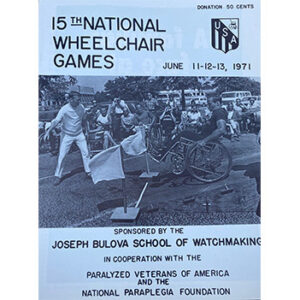
National Wheelchair Games
Move United
National Wheelchair Games held in Jackson Heights, NY
The Paralympic Games were held in Heidelberg
Move United
The NWAA fielded the wheelchair team representing the U.S. at the Paralympic Games held in summer of 1972 in Heidelberg, Germany.
The International Stoke Mandeville Games Federation (ISMGF)
Move United
The ISMGC transformed into the ISMGF to better govern disabled sports and to pioneer the growing interest in national organizations and competitions.
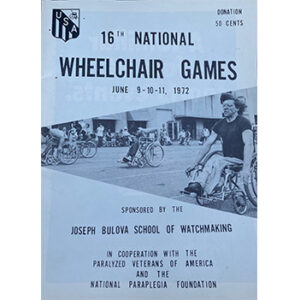
National Wheelchair Games
Move United
National Wheelchair Games held in Jackson Heights, NY
Section 504 of Rehabilitation Act
Move United
Section 504 of the Rehabilitation Act of 1973 was signed in the U.S. on September 26, 1973. This document was one of the first federal rights law in U.S. that prohibited discrimination based on disability. Failure to enforce early versions of the legislation led to protests. One protest was the “504 Sit-In.” During this protest, activists with disabilities conducted a sit-in at federal buildings. Section 504 provided the framework for what would become the Americans with Disabilities Act.
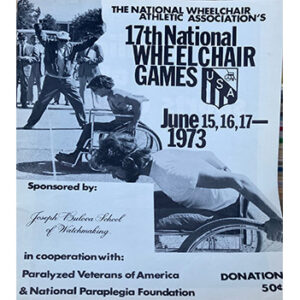
National Wheelchair Games
Move United
National Wheelchair Games held in Jackson Heights, NY
NWAA Certification of Corporation was Filed
Move United
On February 26, under section 402, for the not-for-profit corporation law of the State of New York by Chairman Benjamin H. Lipton and Secretary Edward L McLean for the National Wheelchair Athletic Association, Inc.
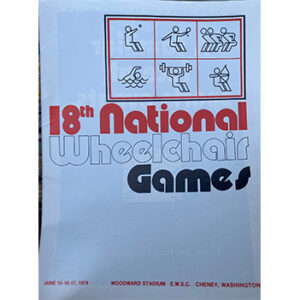
National Wheelchair Games held at Eastern Washington State College in Cheney, WA
Move United
Sports and Spokes
Move United
Cliff and Nancy Crase founded the Sports N Spokes publication. Since 1975, Sports and Spokes has been the premier magazine for wheelchair sports and recreation and has been a catalyst for promoting adaptive sports opportunities and awareness.
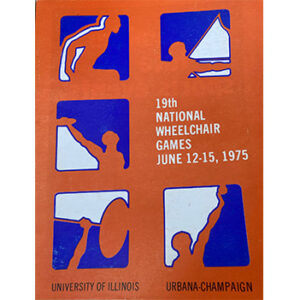
National Wheelchair Games held at the University of Illinois at Urbana-Champaign
Move United
The Paralympic Summer Games were held in Toronto
Move United
The NWAA fielded the wheelchair team representing the U.S. at the Paralympic Games held in summer of 1976 in Toronto, Canada. Blind and amputee athletes were also included in the Toronto Paralympic Games.
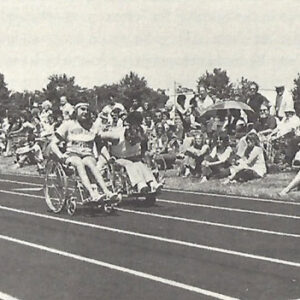
National Wheelchair Games held in Farmingdale, NY
Move United
The First Paralympic Winter Games were held in Örnsköldsvik, Sweden
Move United
Various local organizations operating grassroots programming for athletes with disabilities began to organize in regions around the country
Move United

Inaugural Dixie Games in the Southeast
Move United
Operated by the Dixie Wheelchair Athletic Association, a NWAA chapter member.
Boston Marathon
Move United
In 1977, 7 athletes were entered into the wheelchair division of the race. One honorable mention is Bob Hall. Bob Hall opened up the opportunity for wheelchair athletes to compete in the Boston Marathon by unofficially completing the race two years prior. He made an incredible impact on many other marathons, both nationally and internationally. The committee organizing this participation was a committee of the National Spinal Cord Injury Association and was chaired by Paul DePace.
National Wheelchair Games held in San Jose, CA
Move United
Access is a Fundamental Right
Move United
On November 21st, the International Charter of Physical Education and Sport (UNESCO) declared that sport is a fundamental right. UNESCO claimed that access to physical education and sport is a right that should be guaranteed for all human beings.
The Amateur Sports Act of 1978, signed by President Jimmy Carter, established the United States Olympic Committee (USOC)
Move United
The Act provided National Governing Bodies for each Olympic sport and provided important legal protection for individual athletes.
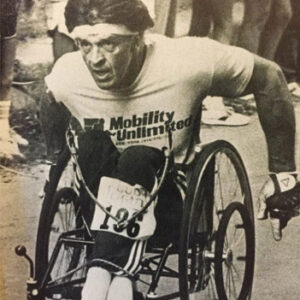
Wheelchair Road Racing
Move United
The late 1970’s commenced the start of Wheelchair Road Racing throughout the country. This sport integrated races with non-disabled runners, leading to an environment of inclusion for races to come. Disabled athletes were finally beginning to receive the recognition and respect that they deserve. A prime example is Marty Ball. Marty was a long-time athlete and leader in wheelchair road racing. He was, and continues to be, one of the “true gentlemen” and “7/24 goodwill ambassadors” in reaching out to new athletes and juniors. He has even contributed significantly to wheelchair design, manufacturing, and technology.
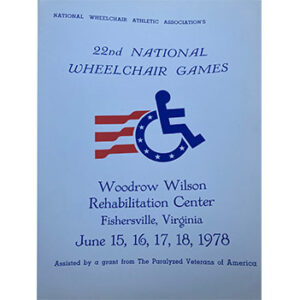
National Wheelchair Games held in Fishersville, VA
Move United
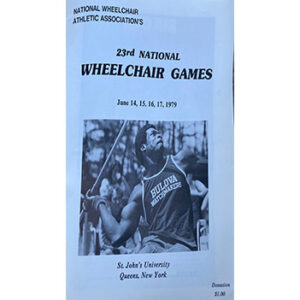
National Wheelchair Games held in St. John’s University, Queens, NY
Move United
The Summer Paralympic Games were held in Arnhem
Move United
The NWAA fielded the wheelchair team representing the U.S. at the Paralympic Games held in summer of 1980 in Arnhem, the Netherlands. Athletes with cerebral palsy were welcomed to participate in the Paralympic Games in 1980.
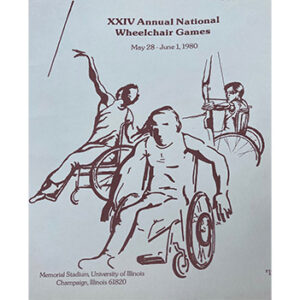
National Wheelchair Games held at the University of Illinois at Urbana-Champaign
Move United
International Year of Disabled Persons
Move United
Due to the push for equality of persons with disabilities, the United Nations named 1981 the “International Year of Disabled Persons.”
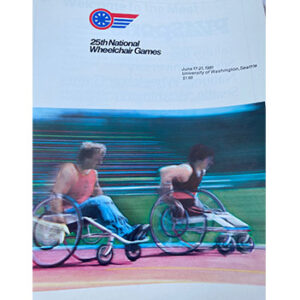
National Wheelchair Games held in Seattle, WA
Move United
The International Coordinating Committee of Sports (ICC)
Move United
The ICC was founded out of a need for the established international organizations serving athletes with a disability to join forces and cooperate. The ISOD, ISMGF, International Blind Sports Federation (IBSA), and Cerebral Palsy International Sports and Recreation Association (CPISRA) are the original organizations behind the ICC and over the years more organizations have joined.
The office of NWAA moved to Colorado Springs, CO
Move United
The office moved from New York to Colorado in an effort to be close to the National Governing Bodies of the core sports of the NWAA. The move created the first professional staff position to administer the organization alongside the Board of Directors.
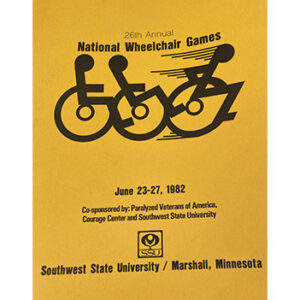
National Wheelchair Games held at Southwest State College in Marshall, MN
Move United

National Wheelchair Games held in Honolulu, HI
Move United
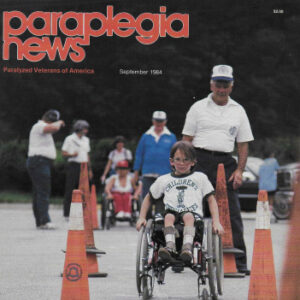
The 1st National Junior Wheelchair Championships Began
Move United
The organization’s largest annual event was first held in the U.S. on July 27th, 28th, and 29th of 1984 in Wilmington, Delaware. The event began with 3 sanctioned events for wheelchair athletes and it is now one of the largest longstanding U.S. multi-sport events for juniors with a physical and/or visual impairment. Sharon Frant Brooks, Andy Chasanoff and Maureen Freda (Petersen) were three of many leading forces in creating the junior competition.

National Wheelchair Games held at Eastern Tennessee State University in Johnson City, TN
Move United
First Wheelchair Sports Demonstration
Move United
NWAA continued to play a key role in putting competitive sports for athletes with a disability on the international stage by promoting a series of exhibition events in wheelchair track at the 1984 Olympic Games in Los Angeles, CA. The first wheelchair sports demonstration events included the Men’s 1500m race and the Women’s 800m race.
The Paralympic Summer Games were held in both Stoke Mandeville UK and Long Island, NY
Move United
Stoke Mandeville attracted wheelchair users and Long Island hosted those who were blind, had Cerebral Palsy and amputees with the NWAA organizing the U.S. presence.
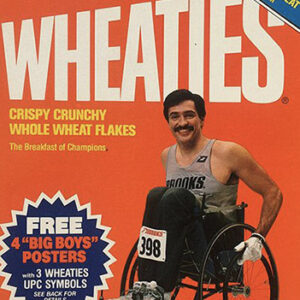
Wheelchair Racer on the Front of a Wheaties’ Box
Move United
In 1984, George Murray appeared on the cover of a Wheaties’ box. Murray’s career includes 2 Boston Marathon championships in the wheelchair division (1978 and 1985); and, he was one of six athletes selected in Wheaties’ first “Search for Champions” contest.
National Junior Wheelchair Championships held in Fishersville, VA
Move United
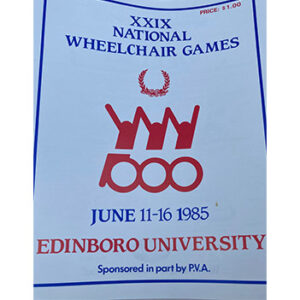
National Wheelchair Games held at Edinboro State College in Edinboro, PA
Move United
National Junior Wheelchair Championships held in Valley Forge, PA
Move United
National Wheelchair Games held at the University of Illinois at Urbana-Champaign
Move United
National Junior Wheelchair Championships held in Lawrenceville, NJ
Move United
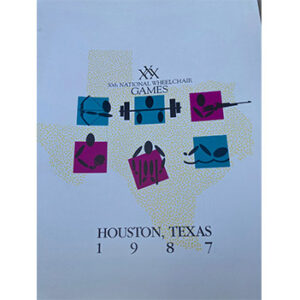
National Wheelchair Games held in Houston, TX
Move United
The Paralympic Summer Games were held in Seoul
Move United
The NWAA fielded the wheelchair team representing the U.S. at the Paralympic Games held in the summer of 1988 in Seoul, South Korea. The 1988 Games marked the first Paralympic Games that were held in the same city at the same venue as the Olympic Games. This was the first time the term “Paralympic” was used.
National Junior Wheelchair Championships held in Johnson City, TN
Move United
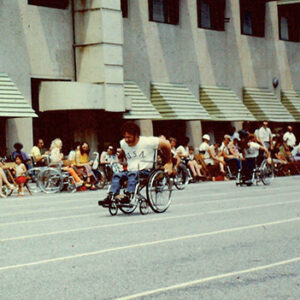
National Wheelchair Games held at Edinboro State College in Edinboro, PA
Move United
The International Paralympic Committee (IPC)
Move United
The IPC was established by the ICC to govern the Paralympic Movement and to organize the Paralympic Games with all the efforts under a single global organization.
National Junior Wheelchair Championships held in Cupertino, CA
Move United
National Wheelchair Games held in Fort Washington, PA
Move United
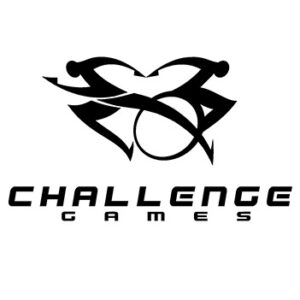
Inaugural Challenge Games in KS
Move United
Operated by the Challenge Foundation, a NWAA chapter member.
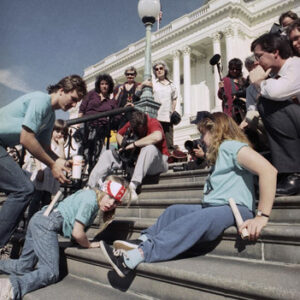
The Capitol Crawl
Move United
On March 12th, Washington D.C. became a platform for the disability rights movement. Activists who had disabilities set aside assisted gear and crawled up capitol building steps in protest. This powerful display inspired hope for disability rights activists.
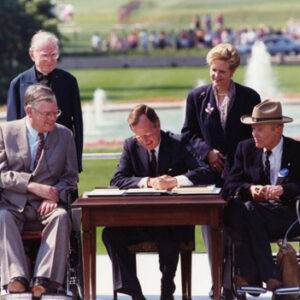
The Americans with Disabilities Act
Move United
On July 26th, U.S. President George H. W. Bush signed the Americans with Disabilities Act. This civil rights law prohibits the discrimination against people who have disabilities.
National Wheelchair Games held at the University of Rhode Island in Kingston, RI
Move United
Inaugural Bennett Institute Games for the Physically Challenged in MD
Move United
Operated by the Bennett Institute for Physically Challenged, a NWAA chapter member. Visit website.
ISMGF Constitution Amended to create the International Stroke Mandeville Wheelchair Sports Federation (ISMWSF)
Move United
To expand past the Paralympic Games, the ISMGF established the International Stoke Mandeville Wheelchair Sports Federation (ISMWSF). The new constitution included a more thorough membership of operations, programs, and competitions.
Wheelchair Sports in the Schools
Move United
In 1991, Bill and Brenda Greene were praised for pioneering and introducing Junior wheelchair sports in their respective school systems and in the greater D.C. area. The couple utilized their experiences with wheelchair basketball to keep Washington’s New Life Air Capital Wheelchair track team going. Greene coached the team as they prepared to participate in the Junior Wheelchair Championships in Princeton, N.J.
National Junior Wheelchair Championships held in Princeton, NJ
Move United
National Wheelchair Games held at Hofstra University in Hempstead, NY
Move United
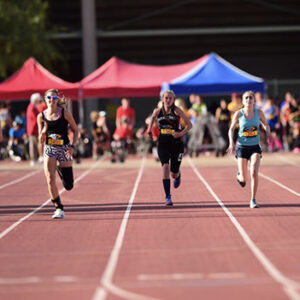
Inaugural Desert Challenge Games in AZ
Move United
Operated by Arizona Disabled Sports, a NWAA chapter member. Visit Website.
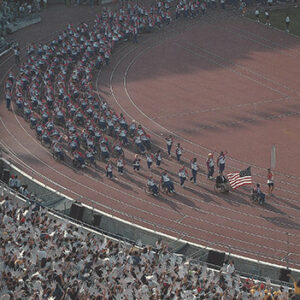
The Paralympic Summer Games held in Barcelona
Move United
The U.S. Disabled Sports Team was formed through five Disability Sport Organizations (DSO’s) joining together to include NWAA, Disabled Sports USA, the Dwarf Athletic Association of America, the United States Association of Blind Athletes and the United States Cerebral Palsy Athletic Association. The Team was the largest and most successful team of athletes with disabilities to date at the Paralympic Games held in the summer of 1992 in Barcelona, Spain. One hundred and thirty members of the U.S. Team were NWAA athletes who earned 55 of the world leading total of 176 medals.
Photo credit: This photo was the cover of Sports and Spokes magazine November December 1992 Volume 18 Number 4 by William R. Sallaz, Denver CO
National Junior Wheelchair Championships held in Orlando, FL
Move United
National Wheelchair Games held in Salt Lake City, UT
Move United
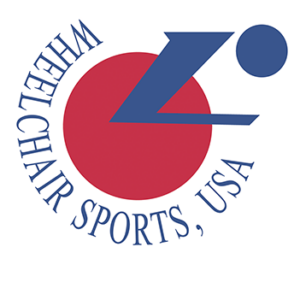
NWAA Changes Name to Wheelchair Sports USA, INC.
Move United
On December 4th, the entity changed their name from the NWAA to Wheelchair Sports USA, Inc. (WSUSA) with the approval of Chairman Paul DePace and Secretary Maureen Freda at the time. Paul DePace was the longest serving member of the organization having served in multiple roles. He portrayed incredible leadership during the organization’s most challenging times, whether it was organizational, financial, inclusiveness, or partnership with the U.S. Olympic Committee (USOC). In addition, he was the longest serving U.S. representative at international leadership, policy, Paralympics, and other respective administrative posts.
National Junior Wheelchair Championships held in Columbus, OH
Move United
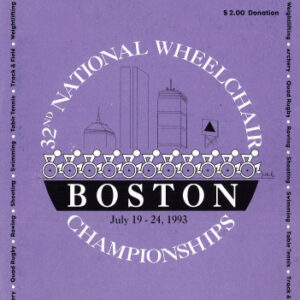
National Wheelchair Games held at UMass in Boston, MA
Move United

Inaugural Southeast Regional Wheelchair Games in the Southeast
Move United
Operated by the Southeastern Wheelchair Sports Association, a WSUSA chapter member. Visit Website.
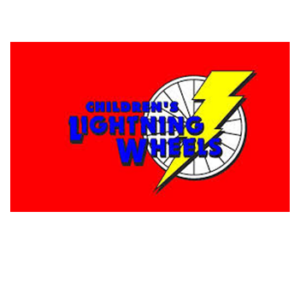
Inaugural Tri-State Regional Swim Meet
Move United
Operated by the Children’s Lightning Wheels, a WSUSA chapter member. Visit Website.
Filing date for Name Change to Wheelchair Sports USA, INC.
Move United
On January 27th, the organization filed to solidify the above name change to better reflect the mission of the organization.
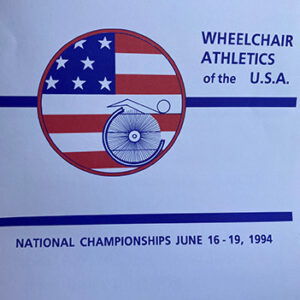
National Junior Wheelchair Championships held in Edmond, OK
Move United
National Wheelchair Games (Track & Field) held in Leesburg, VA
Move United
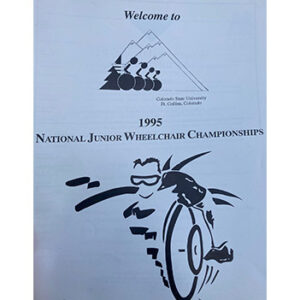
National Junior Wheelchair Championships held in Fort Collins, CO
Move United

Final National Wheelchair Games held at MIT in Boston, MA
Move United
The Paralympic Summer Games were held in Atlanta
Move United
WSUSA fielded the wheelchair team representing the U.S. alongside the U.S. Disabled Sport Team at the Paralympic Games held in the summer of 1996 in Atlanta, United States of America. The 1996 Paralympic Games marked the first time within the U.S. that the Paralympic Games were held in the same city using the same venues at the Olympic Games. The collaboration of the leading DSO’s in the U.S. assisted the Atlanta Paralympic Organizing Committee in winning the opportunity to host the X Paralympic Games in 1996.
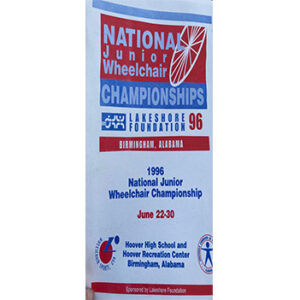
National Junior Wheelchair Championships held in Birmingham, AL
Move United
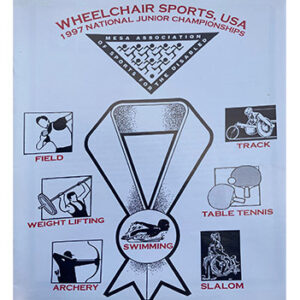
National Junior Wheelchair Championships held in Mesa, AZ
Move United
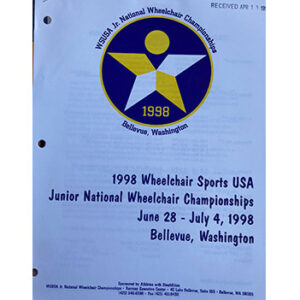
National Junior Wheelchair Championships held in Bellevue, WA
Move United
The Ted Stevens Olympic & Amateur Sports Act revision
Move United
WSUSA and the other DSO’s set the goal of ensuring that the previous Amateur Sports Act of 1978 was revised to require quality support be delivered to athletes with a disability at a level equitable to elite able bodied athletes. The revision, sponsored by then Senator from Alaska, Ted Stevens, stated that amateurism is no longer a requirement for competing in most international sports. It expanded the USOC’s role to include the Paralympic Games, and increased athlete representation and protection. This revision ultimately led to significant changes in the administration of sports for individuals with a disability.
The USOC became the National Paralympic Committee in the U.S.
Move United
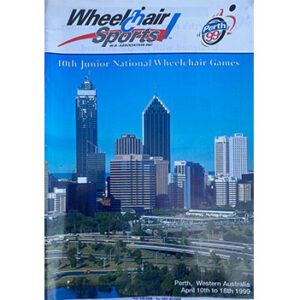
National Junior Wheelchair Championships held in Albuquerque, NM
Move United
The Paralympic Summer Games held in Sydney
Move United
WSUSA fielded the wheelchair team representing the U.S. alongside the U.S. Disabled Sport Team at the Paralympic Games held in the summer of 2000 in Sydney, Australia.
National Junior Wheelchair Championships held in San Jose, CA
Move United

Inaugural UCO Endeavor Games in OK
Move United
Operated by the University of Central Oklahoma,
The International Classification of Functioning, Disability and Health of the World Health Organization was Founded
Move United
The International Classification of Functioning, Disability and Health (ICF) of the World Health Organization (WHO) was founded on May 22nd. The ICF serves as a framework to measure health and disability at both individual and population levels.
The International Seminar on Measurement of Disability
Move United
From June 4th to 6th, the seminar met to discuss the need for international standards for measuring disability. The event resulted in the formation of The Washington Group on Disability Statistics (WG). The WG serves as a United Nations Statistical Commission City Group, and today includes more than 135 countries and organizations.
Paul DePace, President of WSUSA, also elected as President of ISMWSF
Move United
Treaty for Persons with Disabilities
Move United
In December of 2001, the discussion on the Treaty for Persons with Disabilities started in the UN. “Mexico addressed the United Nations General Assembly with a proposal to develop a treaty to protect the rights and dignity of persons with disabilities worldwide.”
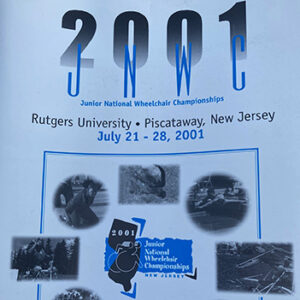
National Junior Wheelchair Championships held in Piscataway, NJ
Move United
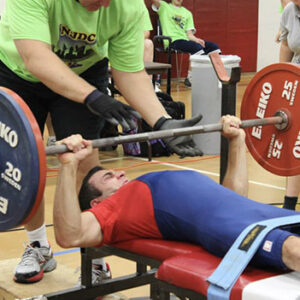
U.S. Paralympics, a division of the USOC, was founded
Move United
In addition to selecting and managing the teams, which compete for the U.S. in the Paralympic Games, U.S. Paralympics took responsibility for supporting the Paralympic community and governing the Paralympic sports of cycling, skiing, swimming and track and field. Other National Governing Bodies took greater ownership of their applicable Paralympic sport and U.S. members of the International Paralympic Federation (wheelchair basketball, boccia, goalball, powerlifting and wheelchair rugby) organized further. DSO’s such as WSUSA were no longer responsible for fielding the national team for their respective disability groups and/or sports and could now focus efforts on support to member organizations as a feeder system into the athlete pipeline.
National Junior Wheelchair Championships held in New London, CT
Move United
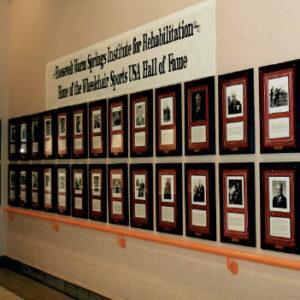
Temporary exhibit of the WSUSA Hall of Fame at the Roosevelt Institute for Rehabilitation in Warm Springs, GA
Move United
Barbara Chambers and Gregg Baumgarten continued leading the Hall of Fame from the early 2000s through 2020 with a temporary exhibit in Warm Springs, GA and future virtual exhibit on the organization website.
The USOC fielded their first official U.S. Team to the Paralympic Winter Games held in Salt Lake City, UT vs. playing a support role since 1996
Move United
National Junior Wheelchair Championships held in New London, CT
Move United
The Paralympic Summer Games held in Athens
Move United
The Paralympic Games were held in the summer of 2004 in Athens, Greece.
National Junior Disability Championships held in Mesa, AZ
Move United
Signature event name change from Junior Wheelchair Championships to the National Junior Disability Championships (NJDC)
ISMWSF and ISOD Merge to Create the International Wheelchair & Amputee Sports Federation
Move United
In 2004, ISMWF and ISOD came together to help grow the Paralympic sport movement. As a result, the International Wheelchair and Amputee Sports Federation (IWAS) was formed. IWAS is still based outside of the Stoke Mandeville Stadium in Aylesbury, where the Paralympic movement began over 60 years ago. WSUSA is the sole U.S. member of IWAS with a mechanism for providing competitive opportunities for athletes seeking to establish themselves on an international stage.
National Junior Disability Championships held in Tampa, FL
Move United
The Convention on the Rights of Persons with Disabilities
Move United
On December 13, The Convention on the Rights of Persons with Disabilities was put into place by the United Nations. The goal of the convention was to protect, promote and ensure all human rights and fundamental freedoms for all people with disabilities.
U.S. Delegation Participates at IWAS Junior World Games
Move United
In 2006, WSUSA sent a U.S. delegation to the IWAS Junior World Games in Dublin, Ireland.
National Junior Disability Championships held in Tampa, FL
Move United
WSUSA recognized by the USOC on the Multi-Sport Organization Council
Move United
DSO’s including WSUSA sit on the Council alongside other Community Based Organizations such as the YMCA, Boys and Girls Clubs of America, the National Collegiate Athletic Association and other well rooted national organizations to develop national interest in sport.
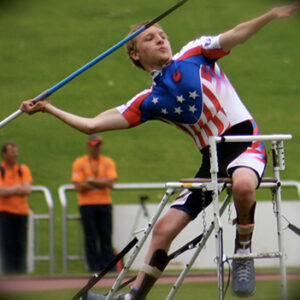
U.S. Delegation Participates at IWAS Junior World Games
Move United
In 2007, WSUSA sent a U.S. delegation to the IWAS Junior World Games in Johannesburg, South Africa.
National Junior Disability Championships held in Spokane, WA
Move United
The Paralympic Summer Games held in Beijing
Move United
The Paralympic Games were held in the summer of 2008 in Beijing, China.
ADA Amendments Act “ADA”
Move United
On September 25th, President George W. Bush signed the ADA Amendments Act. The mission of this act was to create a broader definition of disability.
U.S. Hosts the IWAS Junior World Games in Conjunction with the National Junior Disability Championships
Move United
In 2008, WSUSA sent a U.S. delegation to the IWAS Junior World Games in Piscataway, United States of America. The IWAS World Junior Games were held in conjunction with WSUSA’s National Junior Disability Championships which were led by the Tri-State Wheelchair Athletic Association in Piscataway, New Jersey.
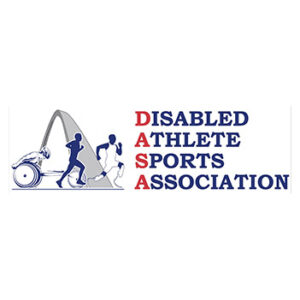
Inaugural Gateway Games in MO
Move United
Operated by the Disabled Athlete Sports Association, a WSUSA chapter member. Visit the Website.
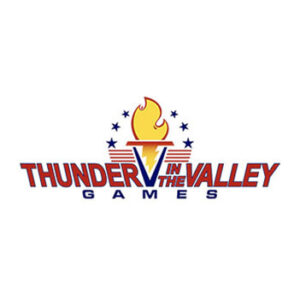
Inaugural Thunder in the Valley Games in MI
Move United
Operated by Michigan Sports Unlimited, a WSUSA chapter member. Visit the Website.
U.S. Delegation Participates at IWAS Junior World Games
Move United
In 2009, WSUSA sent a U.S. delegation to the IWAS Junior World Games in Nottwil, Switzerland.
National Junior Disability Championships held in St. Louis, MO
Move United
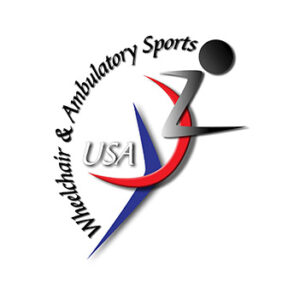
Wheelchair Sports USA, Inc. Changes Name to Wheelchair and Ambulatory Sport USA, Inc.
Move United
On January 26th, the entity changed their name from WSUSA to Wheelchair and Ambulatory Sports, USA, Inc. (WASUSA) to better reflect the population of athletes being served. The name change was a result of several Disabled Sports Organizations dissolving that represented the sporting interests for a specific segment of the disabled population, including organizations representing athletes with Cerebral Palsy and “Les Autres” athletes. Wheelchair Sports USA found its mission changing dramatically from providing sports opportunities to individuals using wheelchairs to serving as a comprehensive competitive sports organization for all individuals with a disability, both ambulatory and non-ambulatory.
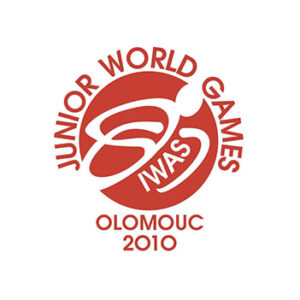
U.S. Delegation Participates at IWAS Junior World Games
Move United
In 2010, WSUSA sent a U.S. delegation to the IWAS Junior World Games in Olomouc, Czech Republic.
The Sport for Development and Peace International Working Group “SDP IWG”
Move United
On May 5th, the Sport for Development and Peace International Working Group was established under the United Nations Office on Sport for Development and Peace (UNOSDP) to promote the power of Sport for Development and Peace and harness the potential of sport.
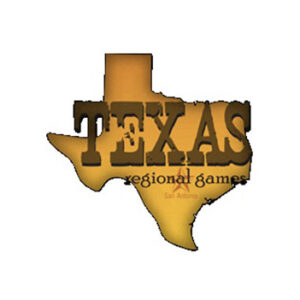
Inaugural Texas Regional Games in TX
Move United
National Junior Disability Championships held in Lake Forest, IL
Move United
National Junior Disability Championships held in Saginaw, MI
Move United
National Junior Disability Championships held in Mesa, AZ
Move United
The Paralympic Summer Games were held in London
Move United
The Paralympic Games were held in the summer of 2012 in London, United Kingdom.
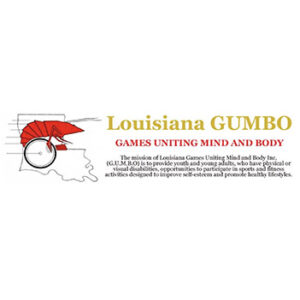
Inaugural GUMBO Acadiana in LA
Move United
U.S. Delegation Participates at IWAS Junior World Games
Move United
In 2013, WSUSA sent a U.S. delegation to the IWAS Junior World Games in Mayaguez, Puerto Rico.

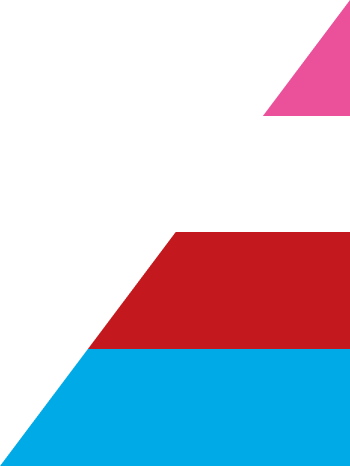
Contact Us
We want to hear from you! Here’s how you can reach us by phone, mail and social media.


